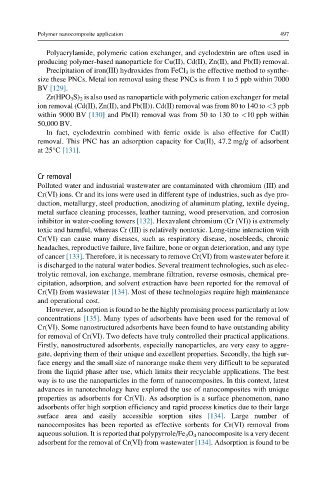Page 544 - Polymer-based Nanocomposites for Energy and Environmental Applications
P. 544
Polymer nanocomposite application 497
Polyacrylamide, polymeric cation exchanger, and cyclodextrin are often used in
producing polymer-based nanoparticle for Cu(II), Cd(II), Zn(II), and Pb(II) removal.
Precipitation of iron(III) hydroxides from FeCl 3 is the effective method to synthe-
size these PNCs. Metal ion removal using these PNCs is from 1 to 5 ppb within 7000
BV [129].
Zr(HPO 3 S) 2 is also used as nanoparticle with polymeric cation exchanger for metal
ion removal (Cd(II), Zn(II), and Pb(II)). Cd(II) removal was from 80 to 140 to <3 ppb
within 9000 BV [130] and Pb(II) removal was from 50 to 130 to <10 ppb within
50,000 BV.
In fact, cyclodextrin combined with ferric oxide is also effective for Cu(II)
removal. This PNC has an adsorption capacity for Cu(II), 47.2 mg/g of adsorbent
at 25°C [131].
Cr removal
Polluted water and industrial wastewater are contaminated with chromium (III) and
Cr(VI) ions. Cr and its ions were used in different type of industries, such as dye pro-
duction, metallurgy, steel production, anodizing of aluminum plating, textile dyeing,
metal surface cleaning processes, leather tanning, wood preservation, and corrosion
inhibitor in water-cooling towers [132]. Hexavalent chromium (Cr (VI)) is extremely
toxic and harmful, whereas Cr (III) is relatively nontoxic. Long-time interaction with
Cr(VI) can cause many diseases, such as respiratory disease, nosebleeds, chronic
headaches, reproductive failure, live failure, bone or organ deterioration, and any type
of cancer [133]. Therefore, it is necessary to remove Cr(VI) from wastewater before it
is discharged to the natural water bodies. Several treatment technologies, such as elec-
trolytic removal, ion exchange, membrane filtration, reverse osmosis, chemical pre-
cipitation, adsorption, and solvent extraction have been reported for the removal of
Cr(VI) from wastewater [134]. Most of these technologies require high maintenance
and operational cost.
However, adsorption is found to be the highly promising process particularly at low
concentrations [135]. Many types of adsorbents have been used for the removal of
Cr(VI). Some nanostructured adsorbents have been found to have outstanding ability
for removal of Cr(VI). Two defects have truly controlled their practical applications.
Firstly, nanostructured adsorbents, especially nanoparticles, are very easy to aggre-
gate, depriving them of their unique and excellent properties. Secondly, the high sur-
face energy and the small size of nanorange make them very difficult to be separated
from the liquid phase after use, which limits their recyclable applications. The best
way is to use the nanoparticles in the form of nanocomposites. In this context, latest
advances in nanotechnology have explored the use of nanocomposites with unique
properties as adsorbents for Cr(VI). As adsorption is a surface phenomenon, nano
adsorbents offer high sorption efficiency and rapid process kinetics due to their large
surface area and easily accessible sorption sites [134]. Large number of
nanocomposites has been reported as effective sorbents for Cr(VI) removal from
aqueous solution. It is reported that polypyrrole/Fe 3 O 4 nanocomposite is a very decent
adsorbent for the removal of Cr(VI) from wastewater [134]. Adsorption is found to be

